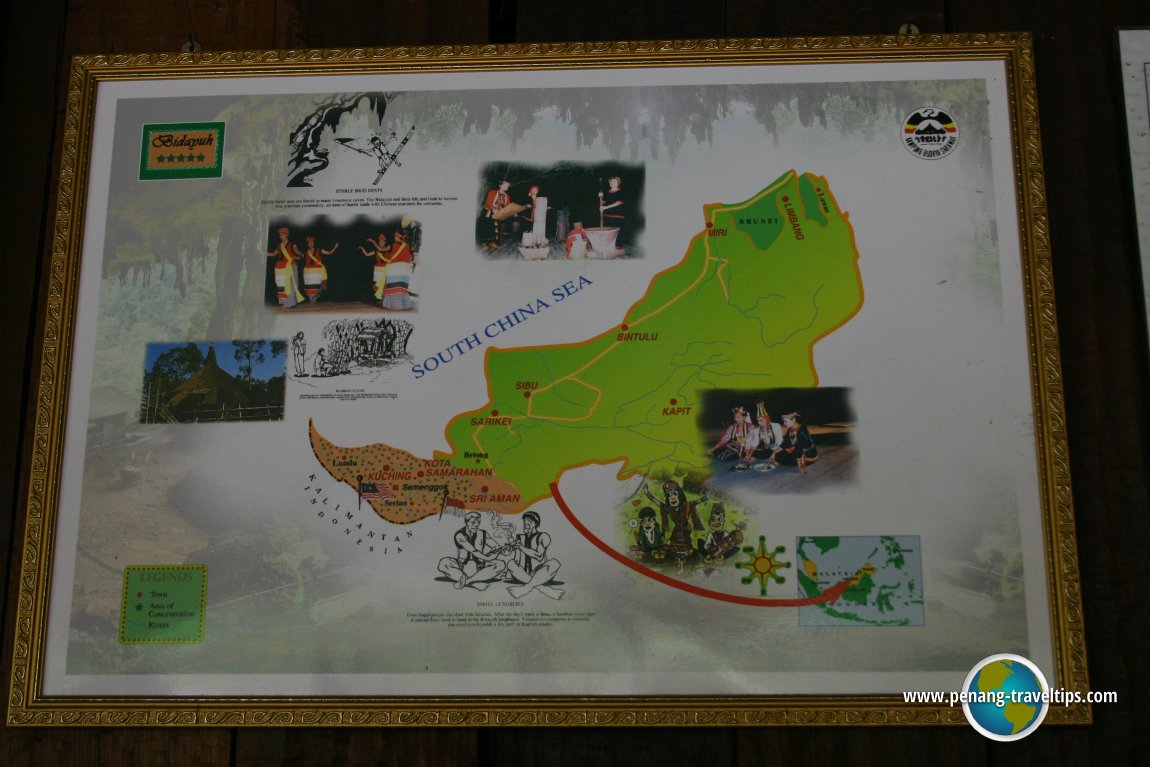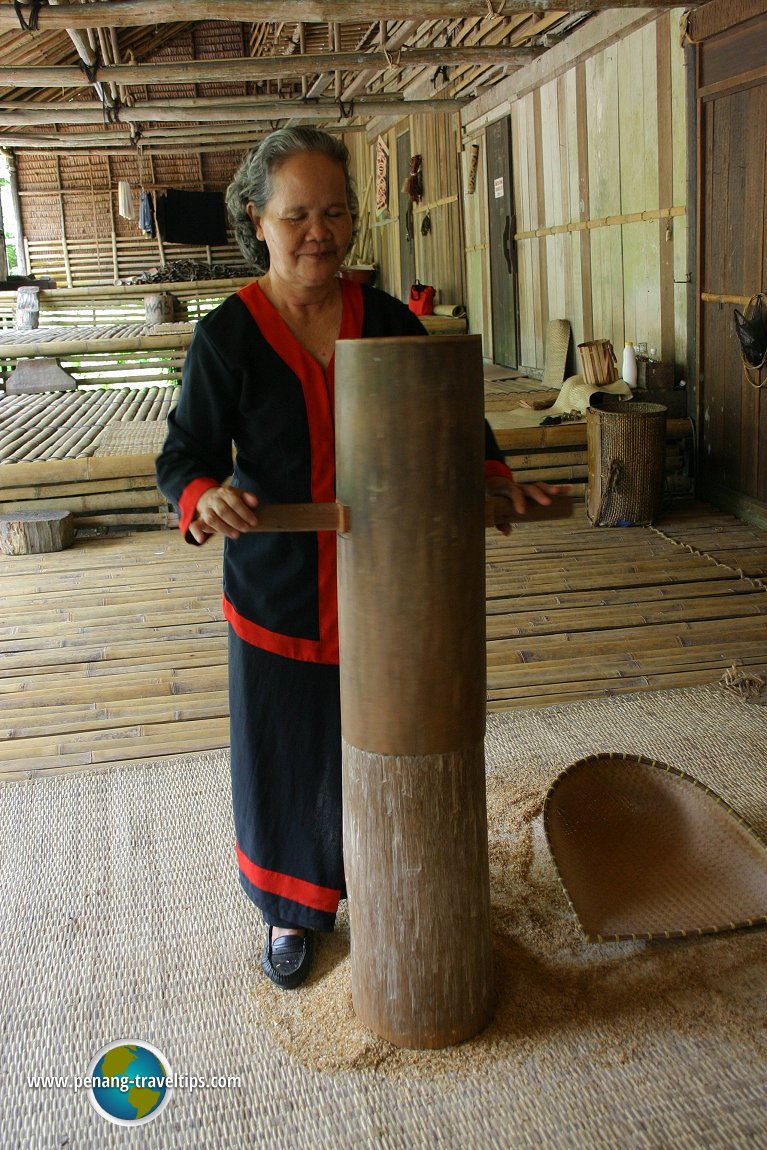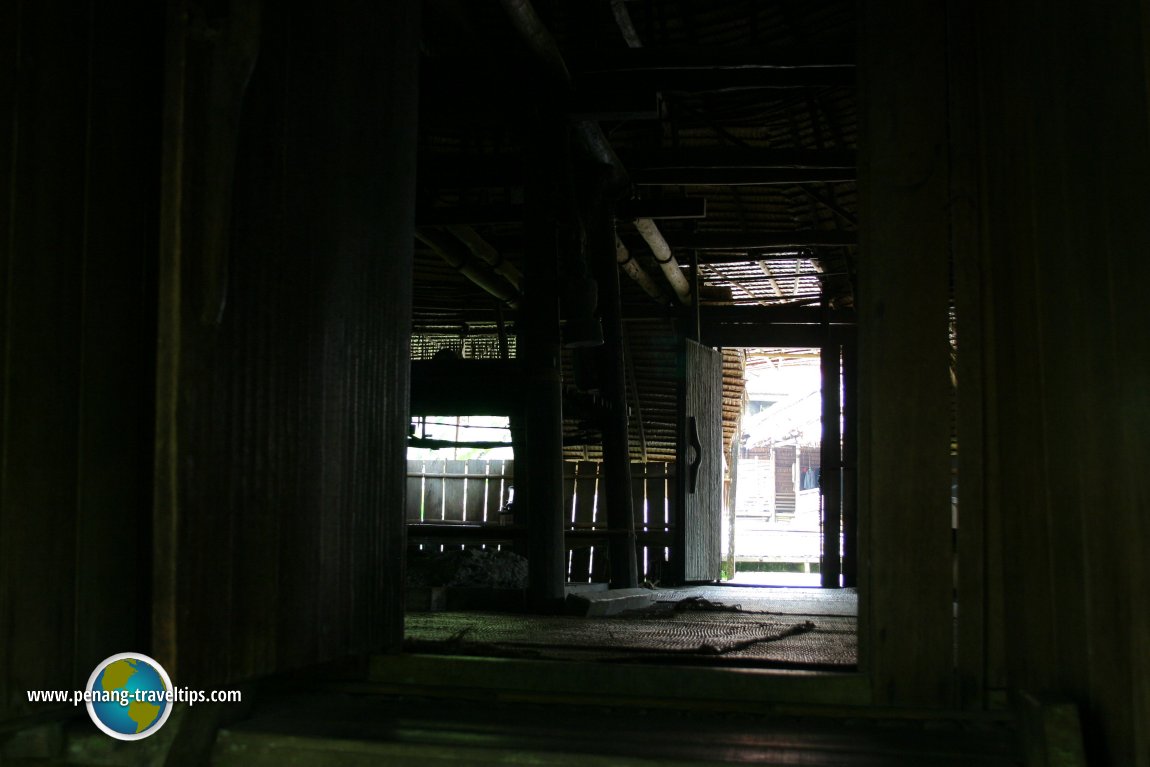 A hornbill crest tops the Bidayuh longhouse (2 October, 2004)
A hornbill crest tops the Bidayuh longhouse (2 October, 2004)
The Bidayuh accounts for 8.4% of the population of Sarawak. They live in the catchment of Sungai Sarawak and Sungai Sadong, in the Kuching and Samarahan divisions of the state. The Bidayuh is the tribe known to Europeans as "Land Dayaks", because of their habitation deep in the limestone mountains, near the water catchment areas of West Sarawak. Like many other tribes in Borneo, the Bidayuh live in long houses, which are really primitive condominiums. The Bidayuh speak a language that can be subdivided into five main dialect groups, namely the Puruh, Jagoi, Siburan, Bukar, Sadong, and Selakau Lara. They cultivate hill padi and cash crops such as pepper, rubber and cocoa.
At the Sarawak Cultural Village, we get to see the traditional houses of the Bidayuh, in particular the longhouse (GPS: 1.74909, 110.31711), where the people live, and the headhouse, which functions as the meeting place for the men.
Bidayuh longhouses often cling to the steep slopes of hills, forming what look like a giant staircase. This offers better protection against invaders, and also because it affords the Bidayuh easier access to fresh water. Approaching a Bidayuh village, longhouse or farm, one usually comes upon carved male and female figurines known as the tegundo. These are spirit effigies to ward off evil. That was when the Bidayuh were still practising animistic beliefs. Today, however, the majority of the Bidayuh have embraced Christianity.
The Bidayuh headhouse is unique among traditional structures of Sarawak. Unlike the longhouse, the headhouse is circular, with a conical roof of thatch. Topping the structure is a hornbill crest. Such a structure is known in the Bidayuh language as panggah or baruk. In addition to being a meeting place, the headhouse is also where the Bidayuh store the prize of their headhunting raids - skulls of their enemies. Single Bidayuh men sleep in the headhouse, ready to spring into action should there be a surprise attack on their village.
Bidayuh men meet in the headhouse to discuss farm work and other community affairs. The headhouse is also where weapons are stored. In the old days, unmarried men would sleep in the headhouse, so that if the village comes under attack, they could spring into action with weapons at the ready.
Drums and gongs are at the ready in the headhouse to call for alarm or for use during ceremonies. On the path leading to a Bidayuh headhouse or farm, one may find the tegundo. These are carved male and female figurines, placed there to ward off evil. The Bidayuh make good use of bamboo. A short distance from the longhouse is a Bidayuh bamboo bridge.
 Traditional distribution of the Bidayuh in Sarawak (2 October, 2004)
Traditional distribution of the Bidayuh in Sarawak (2 October, 2004)
 Entrance to the Bidayuh Headhouse (2 October, 2004)
Entrance to the Bidayuh Headhouse (2 October, 2004)
 The Bidayuh Headhouse as seen from the outside (2 October, 2004)
The Bidayuh Headhouse as seen from the outside (2 October, 2004)
 Bidayuh woman dehusking rice in the longhouse (2 October, 2004)
Bidayuh woman dehusking rice in the longhouse (2 October, 2004)
 Staircase into to the Bidayuh Headhouse (2 October, 2004)
Staircase into to the Bidayuh Headhouse (2 October, 2004)
 View into the Bidayuh Headhouse (2 October, 2004)
View into the Bidayuh Headhouse (2 October, 2004)
 Items on the floor in the Bidayuh headhouse (2 October, 2004)
Items on the floor in the Bidayuh headhouse (2 October, 2004)
 Gongs hanging inside the Bidayuh headhouse (2 October, 2004)
Gongs hanging inside the Bidayuh headhouse (2 October, 2004)
 Next to the headhouse is the Bidayuh longhouse, with gongs and martaban jars lined along the wall (2 October, 2004)
Next to the headhouse is the Bidayuh longhouse, with gongs and martaban jars lined along the wall (2 October, 2004)
 Baskets hanging from the wall of the Bidayuh Headhouse (2 October, 2004)
Baskets hanging from the wall of the Bidayuh Headhouse (2 October, 2004)
 This small basket hanging in the Bidayuh longhouse probably serves as a quiver (2 October, 2004)
This small basket hanging in the Bidayuh longhouse probably serves as a quiver (2 October, 2004)
Return to Sarawak Cultural Village main page
DetailsBack to Discover Kuching mainpage
 Latest updates on Penang Travel Tips
Latest updates on Penang Travel Tips

Copyright © 2003-2025 Timothy Tye. All Rights Reserved.

 Go Back
Go Back